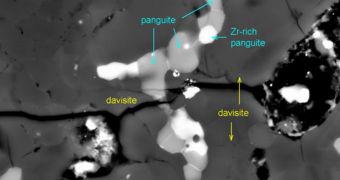More than 40 years after impacting Earth, the Allende meteorite is still providing data that could help us understand how the solar system formed. Just recently, investigators have been able to find an entirely new type of primitive mineral inside the object.
The fact that the space rock still holds mysteries becomes more surprising when considering that – as the world's largest carbonaceous chondrite – it is arguably the most studied meteorite in human history.
Yet, this did not stop experts from the California Institute of Technology (Caltech) from discovering the titanium oxide now called panguite. The name was just approved by the International Mineralogical Association's Commission on New Minerals, Nomenclature and Classification.
Pan Gu belongs to Chinese mythology. He was a giant that separated the yin and the yang, thus creating the Heaven and the Earth. A fitting name for a mineral that could help explain how our planet formed.
Panguite is currently believed to be one of the oldest minerals ever to appear in the solar system, following the formation of the Sun, some 4.6 billion years ago. Details of the substance will be published in the July print issue of the journal American Mineralogist.
“Panguite is an especially exciting discovery since it is not only a new mineral, but also a material previously unknown to science,” explains Caltech senior scientist Chi Ma, who was also a corresponding author on the new paper.
He holds an appointment as the director of the Analytical Facility at the Caltech Geological and Planetary Sciences Division. The Allende meteorite, the expert adds, hit Mexico in 1969, splitting apart in numerous pieces of various sizes in the process.
Thus far, the meteorite has revealed nine new minerals (including this one). “The intensive studies of objects in this meteorite have had a tremendous influence on current thinking about processes, timing, and chemistry in the primitive solar nebula and small planetary bodies,” George Rossman adds.
The expert, a coauthor on the new paper, holds an appointment as the Eleanor and John R. McMillan professor of mineralogy at Caltech. Some of the minerals discovered thus far include allendeite, hexamolybdenum, tistarite, and kangite.
The new study was made possible by the support of the US National Science Foundation (NSF), the Department of Energy (DOE), and the NASA Office of Space Science (OSS).

 14 DAY TRIAL //
14 DAY TRIAL //